Fleas, Ticks, & Mosquitoes
 When it comes to fleas, ticks, and mosquitoes, many pet owners pull their hair out. These pesky critters can cause all sorts of problems, and controlling them is important not only for your pet's health, but also for the health of your home environment.
When it comes to fleas, ticks, and mosquitoes, many pet owners pull their hair out. These pesky critters can cause all sorts of problems, and controlling them is important not only for your pet's health, but also for the health of your home environment.
Let's take a look at the three main offenders, and at what we can do to protect our furry friends:
Fleas...
Fleas
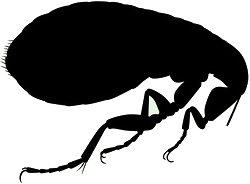 The "cat flea" is the most common, representing about 85-95% of all household fleas found in North America. Even though it is called a cat flea, it also infests both dogs and humans. Other common fleas include the human flea and the dog flea. Fleas can live in both cooler and warmer climates, but are most common in temperatures ranging from 65°F to 80°F, and where the humidity is high (75-85%).
The "cat flea" is the most common, representing about 85-95% of all household fleas found in North America. Even though it is called a cat flea, it also infests both dogs and humans. Other common fleas include the human flea and the dog flea. Fleas can live in both cooler and warmer climates, but are most common in temperatures ranging from 65°F to 80°F, and where the humidity is high (75-85%).
For a pet that already has fleas, one of the most effective methods of flea removal is to lather your pet with a natural shampoo containing tea tree oil (e.g. Dr. Bronner's liquid tea tree oil soap). Giving a bath with a lathering product will drown fleas. Simply leave on the shampoo for 3-5 minutes, no toxic chemicals necessary! This should not be used as a method of flea prevention, however, as frequent shampooing can dry your pet's skin and preventing fleas in the first place is the appropriate solution, but it is a great natural and non-toxic way to remove an infestation from your pet.
Bear in mind that re-infestation will quickly occur if the carpeting, bedding, and other areas are not also taken care of.
How to give your pup a bath...
Ticks...
Ticks
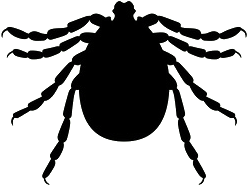 Ticks are parasites that require blood from their host (your cat or dog, or yourself), to sustain life. They generally live in wooded and grassy areas, bushes, and undergrowth. Ticks come in various sizes and types - some are tiny and difficult to see, and some are larger. They attach and embed themselves to skin by inserting a "rostrum" into the skin's surface and anchoring tightly to it.
Ticks are parasites that require blood from their host (your cat or dog, or yourself), to sustain life. They generally live in wooded and grassy areas, bushes, and undergrowth. Ticks come in various sizes and types - some are tiny and difficult to see, and some are larger. They attach and embed themselves to skin by inserting a "rostrum" into the skin's surface and anchoring tightly to it.
How To Remove A Tick 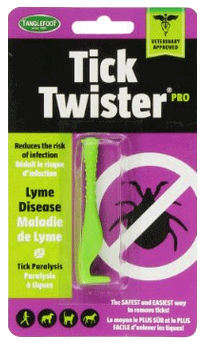 Removing most of the pests you occasionally find on your dog or cat is not a big issue, except for ticks. Ticks bore into your pet's skin using backward-pointing spikes that can make safely removing them difficult. Even with the best insect repellents, you will likely find one of these critters occasionally burrowing into your dog's fur. DO NOT try to remove them by squeezing them or pulling on them with tweezers. This can cause the tick to secrete more saliva, and a piece of the tick's rostrum can remain stuck in the skin because it is surrounded by backward-pointing spikes. The Tick Twister is a great little plastic "tool" that removes a tick by slowly twisting it out, rather than pulling it out. This is important because it also helps to remove the rostrum embedded in the skin. |
For natural protection against ticks and lyme disease in humans AND dogs, check out our blog article.
Mosquitos...
Mosquitoes & Heartworm Disease
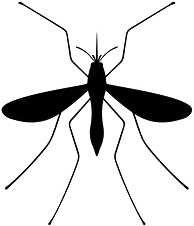 Not only are mosquitoes a nuisance, but they can transmit serious diseases such as heartworm in dogs and cats, and West Nile Virus in other species. This parasitic roundworm is transmitted by the mosquito from dog to dog, and is a major problem not only in many parts of North America, but also in other countries.
Not only are mosquitoes a nuisance, but they can transmit serious diseases such as heartworm in dogs and cats, and West Nile Virus in other species. This parasitic roundworm is transmitted by the mosquito from dog to dog, and is a major problem not only in many parts of North America, but also in other countries.
Heartworms enter the bloodstream as tiny, invisible larvae, and it takes 6-7 months after being bitten before they develop into adult worms. They can then cause serious damage. Heartworms live inside the heart and lungs of dogs (and sometimes ferrets, cats, and other mammals). These worms can grow 12 inches long and live up to 7 years. As the infestation continues, dogs become progressively sicker and can go into heart failure. Symptoms of a heartworm infestation can include labored breathing, coughing, vomiting, weight loss and listlessness, and fatigue. Some dogs show no symptoms until later stages.
Heartworm disease is diagnosed by examination, radiographs or ultrasound, and a blood test. The most common treatment is a series of injections of "adulticides" into the dogs’ muscle. This cure has a high success rate and usually requires hospitalization. In the early stages of infestation, this treatment can be performed on an outpatient basis.
If you live in an area where heartworm is an issue, please talk to your vet about heartworm prevention, which involves giving your pet a once-monthly pill. In some areas that have cool or cold winters, it is only necessary during the summer months. Before the medication is prescribed, a simple heartworm test is administered by your vet to make sure your pet does not already have heartworm. This test is very important, because giving heartworm medication to a pet with heartworm can be fatal.
Check Outside Pets Every Day
If your pet spends a lot of time outdoors, or if you live in an area where fleas, ticks, or mosquitoes are a problem, no matter what pest control solution you use it is important to examine your pet daily. This is especially so when it comes to ticks. Even if you are applying some of the harshest chemical solutions on the market (which I strongly recommend against), your pets can still wind up with these little blood suckers embedded in their coat and skin.
First, let's take a look at conventional pest control products and just how dangerous they are for our pets, and then talk about natural and much safer alternatives.
Conventional Pest Control Products
Conventional pest control products used on pets are toxic by their very nature. They are designed to kill pests because they are pesticides, and when they are applied to a pet's body, these chemicals are then absorbed into their skin. Continually dosing a pet with small amounts of highly toxic pesticides can and does have health consequences.
Environmental Protection Agency (EPA) |
The EPA intensified its evaluation of flea and tick control products and recently issued an advisory about "spot-on" chemical pesticide products such as Frontline and K9 Advantix. These are products applied to the neck or back of dogs and cats as a flea and tick preventive. The advisory was issued due to a significant increase in reported adverse reactions – ranging from mild skin irritation, to seizures and death. In 2008, over 600 deaths and 44,000 reactions presumed to be tied to spot-on products were reported by pet owners, veterinarians, and other animal caretakers, a significant jump from the already high 28,000 from the previous year.
If it is toxic on your skin, it is toxic on your pet's skin
There are many spot-on pest control products on the market, most of which contain toxic chemicals that can poison pets and harm people. Some ingredients are linked to cancer, allergies, and asthma, and product labels warn that they should not touch human skin (but are considered "fine" to place on a pet's skin...).
It is clear that the risks of these products are becoming far too great to warrant their continued use, especially considering there are many safer and more natural alternatives.
EPA Report on Spot-On Products (Frontline, K9 Advantix, etc.)
 Due to the EPA's concern over the number of incidents reported from spot-on product use, they issued a report in 2010 revealing:
Due to the EPA's concern over the number of incidents reported from spot-on product use, they issued a report in 2010 revealing:
- Most incidents occurred in dogs under 3 years old, likely at their first exposure to a spot-on product.
- Most adverse reactions were seen in dogs weighing between 10 and 20 pounds.
- Reactions in mixed breed dogs were most commonly reported, however, the Dachshund, Chihuahua, Miniature Poodle, Pomeranian, Maltese, Shih Tzu, Yorkshire Terrier, and Bichon Frise seem particularly at risk.
- Products containing cyphenothrin and permethrin were especially problematic for small breed dogs. Cyphenothrin is found in many spot-on repellents sold both over the counter and through veterinarians.
- Adverse reactions for both dogs and cats were primarily skin, GI tract, and nervous system related. Skin reactions included itching, redness, hair loss, sores, and ulcers. Spot-on products found to cause these types of reactions included a major market leader.
- Gastrointestinal symptoms included vomiting, diarrhea, and salivation. Spot-on repellents found to cause some levels of these symptoms included another major market leader, whose products have been sold by the millions at major pet store chains across the country.
- Reported nervous system symptoms included lethargy, nervousness, ataxia (movement problems), tremors, and seizure.
- A number of serious adverse reactions in cats were the result of the cat either being treated with a product intended for dogs, or through exposure to a treated dog.
- Inert ingredients in spot-on products were generally assumed to contribute to toxicity.
- Dosage ranges were considered to be too wide in some cases, and product labeling was identified by the EPA as needing revamping in many cases. The EPA's Companion Animal Studies guidelines are insufficient to predict the toxicity of spot-on products.
Avoid all products containing toxic ingredients as much as possible. To check out the ingredients in your flea and tick medication, head on over to the GreenPaws Flea & Tick Products Directory. Each product listed is categorized by risk level to help you assess their toxicity.
Natural Alternatives
Both fleas and ticks have several methods of choosing their host, two of these being by odor and taste. Natural alternatives work by using scents and tastes that make your pet "unattractive" to pests. If the odor of a pet is not what the flea or tick senses as a "food source" then they will look somewhere else. Many of the conventional flea and tick medications on the market today use this method to "mask" the odor of your pet by using harmful toxins.
Let's see how we can naturally protect our pets from these annoying (and disease-carrying) pests:
Use inner defenses...
Parasites always gravitate towards unhealthy animals. Feeding high quality food to dogs and cats improves their health and strengthens their immune system. The goal of preventive pest control is to bring your dog or cat to optimal health, which will make them naturally more resilient and less attractive to pests. A healthy diet includes:
- High quality animal protein (which should be the first 2-3 ingredients on the label)
- High moisture content
- A small amount of fruits and veggies (mimicking the stomach contents of prey)
- No corn, soy, or wheat (these are not canine foods and are common allergens)
- Small quantity of heavy starches (e.g. sweet potatoes or yams)
- Fatty fish (e.g. salmon, sardines, herring, and anchovies, all of which are high in omega-3 fatty acids). These oils help promote healthy skin and fur and can resolve dry skin issues. If possible, sure the fish is wild caught and not farm raised.
What is a healthy, balanced pet diet...
Adding natural products to your dog's food
- Garlic
 A popular Naturopathic recommendation is to mix garlic into your pet's food. Not does garlic help act as a natural insect repellent, but it offers many other benefits such as a bacterial, viral, and fungal protectant, an immune system booster, and a cardiovascular protectant. Dr. Pitcairn, author of the widely respected Dr. Pitcairn's Complete Guide to Natural Health For Dogs & Cats, recommends garlic in the following quantities:
A popular Naturopathic recommendation is to mix garlic into your pet's food. Not does garlic help act as a natural insect repellent, but it offers many other benefits such as a bacterial, viral, and fungal protectant, an immune system booster, and a cardiovascular protectant. Dr. Pitcairn, author of the widely respected Dr. Pitcairn's Complete Guide to Natural Health For Dogs & Cats, recommends garlic in the following quantities:
- 10-15 lbs: 0.5 clove
- 20-40 lbs: 1 clove
- 45-70 lbs: 2 cloves
- 75-90 lbs: 2.5 cloves
- 100+ lbs: 3 cloves
Contrary to the misinformation quoted in other sources, garlic is not toxic to dogs. - Diatomaceous Earth (DE)
DE consists of fossilized marine life with a high silica content. Use only food grade organic DE for your dog or cat (or yourself) and mix it in with food. It helps get rid of lice, ticks, fleas, mites, and worms (except heartworm).
- Kittens (1/4 tsp)
- Cats (1 tsp)
- Small dogs (1/2 tsp)
- Medium dogs, under 50 lbs. (1 tsp)
- Large dogs, over 50 lbs. (1 tbsp)
Use outer defenses...
Bathing your pet with a natural, non-toxic pet shampoo will not only help keep pests away, it will also relieve seasonal itching. Regular brushing or combing (with a flea comb if fleas are the problem) makes it convenient for you to check your pet from head to tail for any pests. It also helps their coat to look fantastic, and it provides a great bonding experience.
Keep your pet's environment clean
Fleas lay their eggs everywhere - in the carpet, animal bedding, furniture, and any cracks or crevices. Vacuuming and washing animal bedding on a regular basis goes a long way in helping to eliminate pest problems in the home. After vacuuming, always replace the vacuum bag, as many pests can survive the vacuuming process.
Use safe and non-toxic pest repellents These products should not contain any toxic or synthetic ingredients. Remember, pets constantly groom themselves and lick their skin. Natural, safe, oils make for the best ingredients. Look for products that work effectively to repel fleas, ticks, mosquitos, and flies. They should not stain fur, nor irritate your pet's skin. Examples of natural products include:
These products should not contain any toxic or synthetic ingredients. Remember, pets constantly groom themselves and lick their skin. Natural, safe, oils make for the best ingredients. Look for products that work effectively to repel fleas, ticks, mosquitos, and flies. They should not stain fur, nor irritate your pet's skin. Examples of natural products include:
- Curealia Natural Insect Repellent
- Only Natural Pet Herbal Defense Spray
- Only Natural Pet Herbal Defense Squeeze-On (dogs | cats)
- Dr. Mercola's Natural Flea & Tick Defense
- Wondercide Natural Flea, Tick, & Mosquito Repellent***
- Sentry Natural Defense Squeeze-On (dogs | cats)***
*** We use a combination of the squeeze-on every 2 weeks AND a light spraying of Wondercide daily on our pup.
Products containing the following oils also repel pests:
- Lemongrass oil - helps repel fleas, ticks, and mosquitoes.
- Cinnamon oil - helps repel fleas, ticks, mosquitoes, and other pests.
- Sesame oil - combined with other essential oils, it helps protect against pests.
- Castor oil - used for years by veterinarians to help repel a variety of pests.
- Geraniol - a powerful flea control ingredient used in natural repellents.
Avoiding mosquitoes...
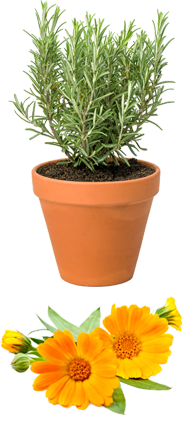 Eliminate breeding sites
Eliminate breeding sites
Avoid having any standing water in your yard. If you have a water feature, aerate it with a small pump so that the water circulates rather than remains stagnant.
- Plant mosquito-repelling plants
There are also various types of plants that naturally repel mosquitoes, including:
- Rosemary
- Citronella grass
- Horsemint
- Marigolds
- Catnip
- Basil
- Lavender - Reduce your pet's exposure
Keep your pets indoors during early morning and early evening, when the mosquito population is the most dense. Avoid bringing your pet to marshy areas. - Use natural mosquito repellents
- Repel Lemon Eucalyptus Oil
- A 2002 New England Journal of Medicine study compared synthetic chemical repellents to herbal repellents and found Repel Lemon Eucalyptus Repellent to be more effective than products containing the toxic insect repellent Deet.
- A USDA study compared 4 synthetic mosquito repellents to 8 natural ones, and found Repel Lemon Eucalyptus to be more effective.
Even though this product states it should be used on humans only, the active ingredients are considered safe for dogs and are used in other natural pest repellent products for dogs. Daisy Paw Collars is one example (see below). - Geranium, Soybean, & Coconut Oil Bite Blocker (for cats)
Bite Blocker contains the oils of geranium, soybean, and coconut and is available as a pet spray.
- The New England Journal of Medicine study found that Bite Blocker provided 94.6 minutes of protection against mosquitoes. This is slightly more effective than Off Skintastic for Kids (containing 4.75% DEET), which provided 88.4 minutes of protection.
- A study by the USDA ranked Bite Blocker number two in effectiveness after Repel. Bite Blocker was rated more effective than a synthetic 7% DEET mosquito repellent. - Daisy Paw Collars
These are collars available in many different colors to which different essential oils can be added. One blend called "De-Bugged" contains a combination of lavender and lemon eucalyptus, which is effective against pests. - Thyme
- Clove oil
- Celery extract
- Neem oil
- Repel Lemon Eucalyptus Oil
- Use heartworm medication
See your vet about whether you live in an area where you need to use a heartworm preventative.
If You Must Use A Chemical Insect Repellent
If, for some reason, you are unable to avoid a chemical pest control agent (such as when visiting an area where there are infestations of pests, or dangerous diseases from pests, such as leishmaniasis in the Mediterranean), please follow these very important steps to reduce the toxic risk to your furry loved one:
- Be very careful to follow dosing directions on the label, and if your pet is at the low end of a dosage range, step down to the next lowest dosage.
- Be extremely cautious with small dogs.
- Carefully monitor your pet for any symptoms or adverse reactions they may have after applying. The EPA has reported many side effects from spot-on treatments, including listlessness, vomiting, loss of appetite, drooling, seizures, and skin reactions.
- Feed a high quality diet to help strengthen their immune system and counter the negative effects of the chemicals.
- NEVER apply dog products to a cat. The adverse reaction could be fatal.
- Rotate chemical treatments with natural ones that are proven to be effective. Consult a Naturopathic vet (or traditional vet that also incorporates a more natural approach to veterinary care) about natural solutions available.
RELATED ARTICLES
- Why pets are getting sicker
- Fleas, ticks, & mosquitoes
- Natural dog grooming
- Pet vaccinations
- Declawing
- Healthy & balanced pet diet
- Home-cooked diet
- Raw food diet for pets
- Home-baked doggy treats
- Bones - nature's toothbrush
- Pet-proofing your home
- Preparing for a new pet!
- Treating common pet injuries
- Pet dental care